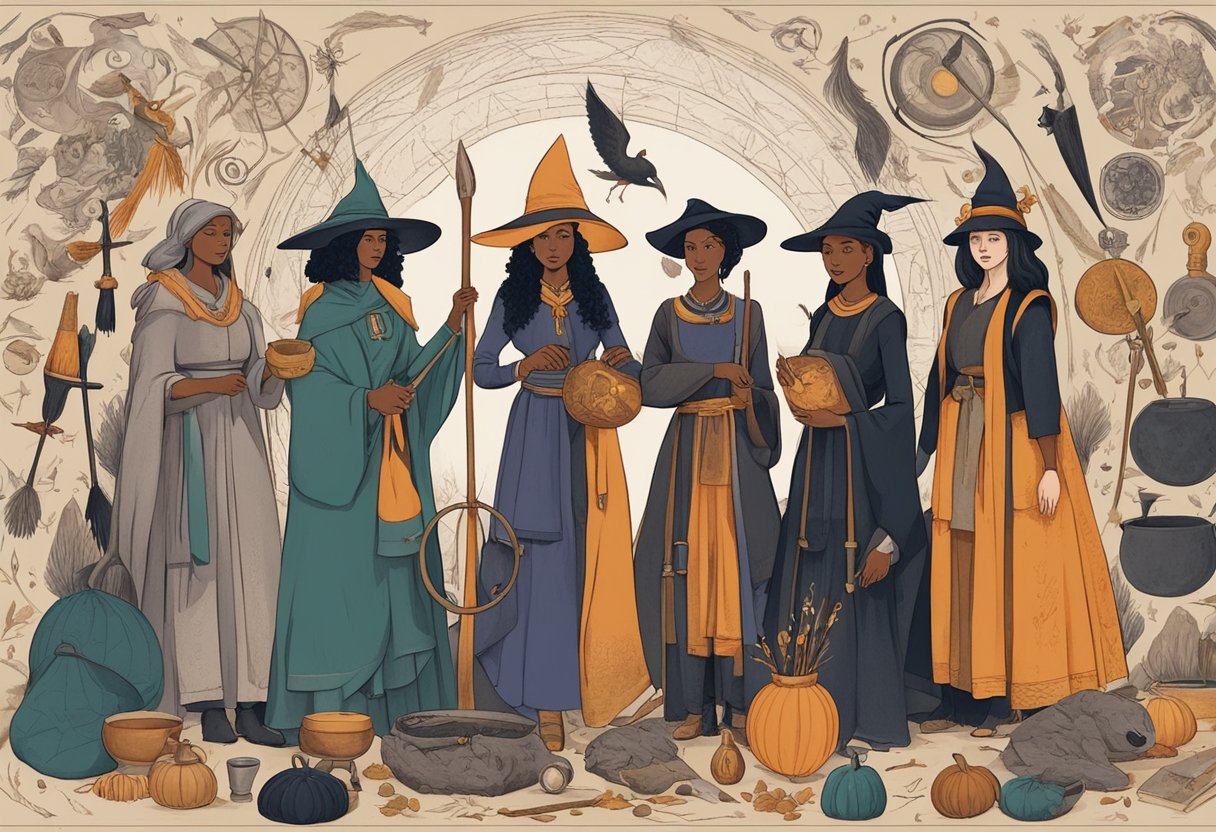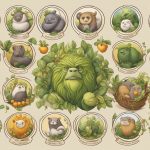Types Of Witches
Types of witches have been a part of human history and culture for centuries. Witchcraft and magic practices vary greatly depending on the individual, their beliefs, and cultural context. Today, many people still practice witchcraft and identify with different types of witches.
There are many different types of witches, each with their own unique practices and beliefs. Some of the most common types of witches include green witches, kitchen witches, hedge witches, and eclectic witches. Green witches often focus on nature and herbalism, while kitchen witches use cooking and food as a form of magic. Hedge witches are known for their ability to communicate with spirits and the spirit world, while eclectic witches draw from a variety of magical traditions.
Understanding the different types of witches and their practices can help individuals connect with their own path and find a community that aligns with their beliefs. Whether someone is new to witchcraft or has been practicing for years, there is always something new to learn and explore.
Key Takeaways
- Witchcraft and magic practices vary greatly depending on the individual, their beliefs, and cultural context.
- There are many different types of witches, each with their own unique practices and beliefs.
- Understanding the different types of witches and their practices can help individuals connect with their own path and find a community that aligns with their beliefs.
Historical and Cultural Context

Witches have a long and complex history, with different cultural and historical contexts shaping their representation and beliefs. Throughout history, witches have been portrayed as evil, powerful beings who use magic to harm others. However, the reality is far more complex, with witches often being healers, midwives, and practitioners of folk magic.
Salem Witch Trials
One of the most well-known events in the history of witches is the Salem Witch Trials, which took place in colonial Massachusetts in the late 17th century. During this time, over 200 people were accused of witchcraft, with 20 being executed. The trials were fueled by religious and social tensions, with many of the accused being women who were seen as outsiders in the community.
Gerald Gardner and Wicca
In the 20th century, a new form of witchcraft emerged known as Wicca. This modern form of witchcraft was created by British occultist Gerald Gardner in the 1950s and 1960s. Gardner drew on a variety of sources, including folk magic, ceremonial magic, and occultism, to create a new form of witchcraft that was focused on the worship of nature and the goddess.
Overall, the history of witches is both complex and fascinating, with different cultural and historical contexts shaping their representation and beliefs. From the Salem Witch Trials to the emergence of Wicca, witches have played an important role in religion, folklore, and popular culture.
Types of Witches and Their Practices
Witches are practitioners of magic who use their knowledge and skills to affect change in the world around them. There are many different types of witches, each with their own unique practices and traditions. In this section, we will explore some of the most common types of witches and the practices associated with them.
Green Witch
The Green Witch is a type of witch who is deeply connected to nature. They often work with plants, herbs, and other natural materials to create spells and potions. Green Witches are also known for their ability to communicate with animals and the spirits of the natural world. They may also practice gardening and other forms of earth-based spirituality.
Kitchen Witch
The Kitchen Witch is a type of witch who uses cooking and food preparation as a form of magic. They may use herbs, spices, and other ingredients to create spells and potions, or they may simply infuse their food with positive energy and intention. Kitchen Witches are also known for their ability to create a warm and welcoming home environment.
Hedge Witch
The Hedge Witch is a type of witch who practices a form of folk magic that is deeply rooted in nature and the cycles of the seasons. They may work alone or in small groups, and their practices often involve herbalism, divination, and other forms of earth-based spirituality. Hedge Witches are also known for their ability to communicate with spirits and the otherworld.
Sea Witch
The Sea Witch is a type of witch who is deeply connected to the ocean and its creatures. They may work with shells, seaweed, and other oceanic materials to create spells and potions, or they may simply spend time by the ocean to connect with its energy. Sea Witches are also known for their ability to communicate with the spirits of the sea and the creatures that live within it.
Ceremonial Witch
The Ceremonial Witch is a type of witch who practices a form of magic that is highly structured and ritualistic. They may work with a coven or other group of practitioners, and their practices often involve complex ceremonies and invocations. Ceremonial Witches are also known for their ability to work with the elements and the spirits of the natural world.
Eclectic Witch
The Eclectic Witch is a type of witch who draws from many different traditions and practices to create their own unique form of magic. They may work with herbs, crystals, tarot cards, and other tools to create spells and potions, or they may simply rely on their own intuition and connection to the natural world. Eclectic Witches are also known for their ability to adapt their practices to suit their individual needs and preferences.
In conclusion, there are many different types of witches, each with their own unique practices and traditions. Whether you are drawn to the natural world, the cycles of the seasons, or the power of ritual and ceremony, there is a type of witchcraft that is right for you.
Witchcraft Tools and Elements
Witches use a variety of tools and elements to enhance their magical workings. In this section, we’ll explore some of the most commonly used tools and elements in witchcraft.
Crystals and Stones
Crystals and stones have been used in magic for centuries. Each crystal has its own unique properties and can be used for a variety of purposes. For example, rose quartz is often used for love spells, while amethyst is used for healing and protection. Witches often carry crystals with them or place them on their altars to enhance their magic.
Herbs and Plants
Herbs and plants are another important tool in witchcraft. Each herb has its own unique properties and can be used for a variety of purposes. For example, lavender is often used for relaxation and sleep, while sage is used for purification and protection. Witches often use herbs in their spells, potions, and rituals.
Tarot and Divination
Tarot and divination are tools that witches use to gain insight into the future and to answer questions. Tarot cards are a deck of 78 cards that each have their own unique meanings. Witches often use tarot cards to gain insight into their own lives or to help others. Divination tools such as pendulums, runes, and scrying mirrors are also commonly used in witchcraft.
Overall, witches use a variety of tools and elements to enhance their magic. Crystals, herbs, and tarot cards are just a few of the many tools that witches use in their practice. By using these tools, witches are able to tap into the power of the elements and the universe to manifest their desires.
Witchcraft in Modern Society
Witchcraft has been practiced for centuries and has evolved over time to adapt to modern society. With the rise of the feminist movement and the increasing interest in alternative spiritual practices, witchcraft has gained more attention in recent years.
Feminist Witchcraft
Feminist witchcraft is a type of witchcraft that emphasizes the power of women and the importance of female spirituality. It is often associated with the Dianic tradition, which focuses on the worship of the goddess and the celebration of femininity. Feminist witches believe that women have been oppressed throughout history and that witchcraft can be a tool for empowerment and liberation.
Secular vs. Religious Witchcraft
Witchcraft can be practiced in both a secular and religious context. Secular witches do not necessarily believe in a specific deity or follow a particular religious tradition. They may view witchcraft as a form of self-expression or personal growth. Religious witches, on the other hand, often follow a specific spiritual path, such as Wicca or Paganism, and view witchcraft as a way to connect with the divine.
In modern society, witchcraft has become more accepted and mainstream. Many practitioners have formed communities and created sacred spaces where they can come together to practice and share their knowledge. Whether one practices witchcraft for personal growth, spiritual connection, or empowerment, it is clear that witchcraft has a place in modern society.
Connecting with the Natural and Spirit Worlds
Witches who connect with the natural and spirit worlds use their craft to tap into the energy that surrounds them. They draw upon the elements of the earth and the cosmos to create spells and rituals that harness the power of nature.
Elemental Witchcraft
Elemental witches work with the four elements of the natural world: earth, air, fire, and water. They believe that each element has its own unique energy that can be used for magical purposes. For example, earth represents stability and grounding, while air represents communication and intellect.
Elemental witches often use correspondences to help them connect with the elements. They might use certain herbs, crystals, or colors in their spells and rituals to enhance the energy of a particular element. They might also create altars or sacred spaces that represent each element.
Lunar and Cosmic Witchcraft
Lunar and cosmic witches connect with the energy of the moon and the stars. They believe that the cycles of the moon and the movements of the planets have a profound effect on our lives and our magic. Lunar witches might perform spells or rituals during different phases of the moon, while cosmic witches might use astrology to guide their magical workings.
Lunar and cosmic witches might also work with entities from the spirit world, such as faeries or other celestial beings. They might use divination tools like tarot cards or runes to communicate with these entities and gain insight into their magic.
Overall, witches who connect with the natural and spirit worlds are deeply attuned to the energy that surrounds them. They use their craft to tap into this energy and create powerful spells and rituals that can transform their lives and the lives of those around them.

